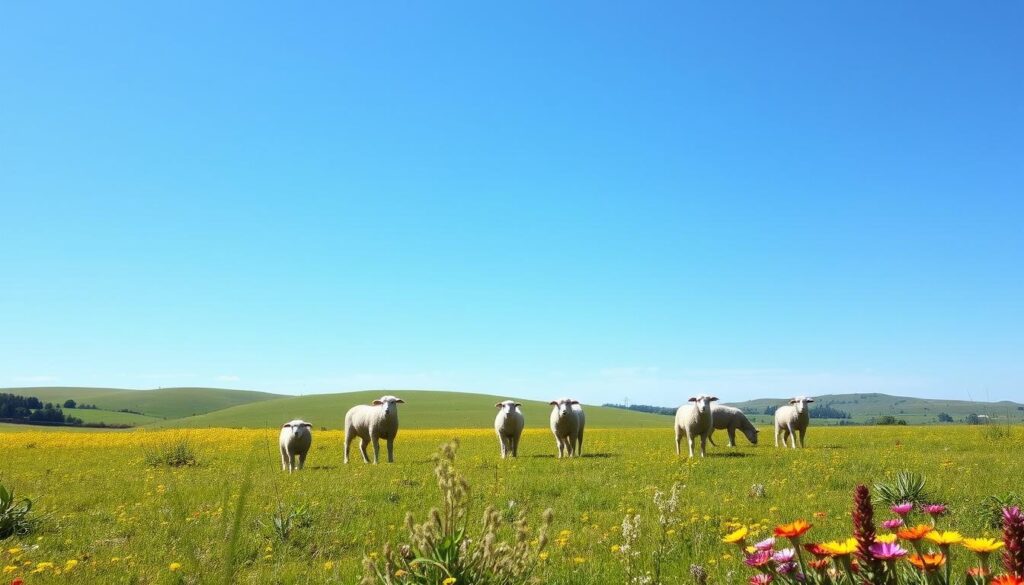As you stand in the butcher’s shop, the smell of freshly cut lamb chops fills the air. It’s a tempting aroma that draws you in. You’ve always loved the rich, full-bodied flavor of lamb, and today you’re on a quest to find the best cuts.
But what makes some lamb cuts more pricey than others? Let’s explore the world of premium lamb together. We’ll uncover the secrets behind the most sought-after and prestigious cuts of this delicious protein.
Table of Contents
Understanding Premium Lamb Cuts and Their Value
Lamb cuts vary in price. This is due to quality, demand, and how rare they are. Knowing what affects lamb prices helps you choose the best cuts.
Factors Affecting Lamb Cut Prices
Several things influence lamb prices. The type of cut, meat quality, and market demand are key. Premium cuts like rack of lamb and loin chops are pricier because they’re tender and flavorful. But, cuts like lamb shoulder and leg are more affordable and still great value.
Quality Indicators in Premium Lamb
Quality is crucial for premium lamb. Look for these signs of high-quality meat:
- Marbling: Good marbling makes the meat tender and juicy.
- Color: A bright, cherry-red color means the meat is fresh and quality.
- Age: Younger lambs, under 12 months, are more tender and taste better.
Market Demand and Pricing Trends
Lamb is less popular in the US than beef or chicken. Americans eat only about a pound of lamb each year, compared to 60 pounds of beef. This lower demand makes premium lamb more expensive. Also, grass-fed and organic lamb costs more than regular lamb.
What is the Most Expensive Cut of Lamb?
The rack of lamb is the most expensive and prestigious lamb cut. It’s known for its tender meat, rich flavor, and impressive look. It’s also great for many cooking methods.
This cut, also called the “lamb rib primal cut,” has a row of rib bones. It’s covered in a thick layer of premium lamb meat. Its taste is rich and slightly sweet, making it stand out and cost more than other gourmet lamb cuts.
| Lamb Cut | Average Price per Pound |
|---|---|
| Rack of Lamb | $19.99 – $34.99 |
| Lamb Loin Chops | $12.99 – $24.99 |
| Leg of Lamb | $9.99 – $19.99 |
| Lamb Shoulder | $6.99 – $14.99 |
The rack of lamb’s high price shows its top-notch quality and versatility. It’s perfect for grilling, roasting, or in fancy dishes. It always offers a fantastic taste, making it the priciest expensive lamb cut available.
Exploring the Prestigious Rack of Lamb
The rack of lamb is a top choice among lamb lovers. It’s made from tender and flavorful rib meat, attached to the bone. This makes it perfect for special meals and fancy lamb dishes.
Anatomy of a Rack of Lamb
A rack of lamb has 7-8 rib bones. It includes the tender loin muscle and fat cap. The French-trimmed version, or Frenched rack, has the bones exposed for a fancy look. Its tenderness and rich flavor make it a favorite among lamb fans.
Why Rack of Lamb Commands Premium Prices
The rack of lamb is known for its high quality. Its limited availability, soft texture, and cooking versatility make it pricey. Whether roasted, grilled, or seared, it offers a unique dining experience. This justifies its status as a top lamb cut.
Preparing and Serving Rack of Lamb
Preparing a rack of lamb right is key to its flavor and texture. Season the meat, sear it for a crispy outside, and then oven-finish it to medium-rare. Serving it whole or as individual chops lets diners enjoy the tender meat and stunning look.
Premium Lamb Loin: A Close Second
The lamb loin is a top choice after the rack of lamb. It’s known for its tenderness and rich flavor. Lamb loin chops are loved by both home cooks and chefs for their great taste and versatility.
This cut has the perfect mix of lean meat and fat. It’s juicy and full of flavor. Even though it’s not as showy as a rack, its taste and versatility make it very popular.
The lamb loin is a bit cheaper than the rack but still costs more. It’s valued for its quality and the effort needed to prepare it. It’s a favorite in fancy kitchens and among those who love good food.
Exploring the Lamb Loin
The lamb loin is a must-try for its flavor and tenderness. It’s great for many cooking methods, like grilling, pan-searing, and roasting. It’s a favorite among both home cooks and chefs.
- Lamb loin chops are known for their tenderness and juicy meat, making them ideal for grilling, pan-searing, or roasting.
- Lamb shoulder chops come from the shoulder area of the lamb and may contain more connective tissue, requiring slightly longer cooking times for tenderization.
- Lamb breast chops are taken from the belly area of the lamb and are known for their rich, fatty flavor and tenderness when cooked properly.
Preparing the lamb loin any way you like will impress everyone. It’s a standout among premium lamb cuts for its amazing flavor and texture.
The Art of Selecting Quality Lamb Chops
Lamb chops are often overlooked, but they can be a true culinary gem. They come in various cuts, each with its own flavor and price. To find the best lamb chops, it’s key to know the different types, look for premium characteristics, and compare prices.
Different Types of Lamb Chops
Lamb chops fall into three main categories:
- Rib Chops: These are from the rib section, known for tenderness and rich flavor.
- Loin Chops: From the loin area, these are tender and flavorful, with a delicate texture.
- Shoulder Chops: Cut from the shoulder, these are less expensive but offer a bold flavor.
Identifying Premium Chop Characteristics
Look for quality lamb chops with a bright pink to red color. They should have fine-grained meat with moderate marbling and creamy white fat. Avoid chops with too much fat or discoloration, as they may be lower quality.
Price Comparison Between Chop Varieties
The price of lamb chops varies by cut and quality. Rib chops and loin chops are pricier due to their tenderness and flavor. On average, rib chops cost $20 to $30 per pound, and loin chops $15 to $25 per pound. Shoulder chops are more affordable, priced between $10 to $18 per pound.
When choosing lamb chops, think about your budget and preferences, and the dish you’re making. Knowing the types, looking for premium characteristics, and comparing prices helps you make a good choice. This way, you can enjoy the rich flavors of premium lamb chops.
Cooking Methods for Expensive Lamb Cuts
Preparing premium lamb cuts needs careful cooking techniques. This ensures their quality and flavor stay top-notch. From the famous rack of lamb to the sought-after lamb loin chops, the right cooking method can make these dishes even better.
The rack of lamb is best cooked at high temperatures, around 400°F to 450°F. This method gives a caramelized outside and a juicy inside. Grilling adds a smoky flavor, while searing and then oven cooking creates a crispy crust. Sous vide cooking ensures lamb is always perfectly cooked.
Lamb loin chops should be seared quickly to keep juices in and create a flavorful crust. Cooking them in the oven or on the grill at medium-rare to medium doneness makes them tender and juicy.
It’s important to check the internal temperature of these lamb cuts. This is key to getting the right doneness, which is usually medium-rare for the best taste and texture.

Premium lamb cuts offer many cooking options, from roasting and grilling to sous vide. By learning these techniques, both home cooks and chefs can improve their cooking lamb and gourmet lamb dishes. This leads to better premium lamb preparation and flavor.
Understanding Lamb Grading and Quality Standards
Choosing the best lamb cuts means knowing the grading system. The United States Department of Agriculture (USDA) rates lamb by quality and yield. The top grade is Prime, followed by Choice, Good, and Utility. These grades look at marbling, color, texture, and the animal’s age.
USDA Grading System for Lamb
The USDA grading system for lamb helps judge quality and characteristics. Lamb graded as Prime has the most marbling, making it tender and flavorful. Choice lamb is also high quality but with less marbling. Good and Utility grades have even less marbling and are less desirable.
International Lamb Quality Standards
Other countries have their own lamb quality standards. For example, Australia uses MSA (Meat Standards Australia). It considers tenderness, juiciness, and flavor. Knowing these standards helps consumers choose the best lamb cuts.
Learning about the USDA lamb grading system and international standards helps consumers. They can then pick the high-quality lamb that suits their taste and budget.
Sourcing Premium Lamb: From Farm to Table
Getting the best lamb is all about the journey from farm to table. Knowing what makes lamb great can make your meal unforgettable.
Choosing the right lamb starts with where it comes from and how it’s raised. Local lamb farmers often have the best product. This is because their lamb is raised naturally and sustainably. Grass-fed lamb is especially popular for its health benefits and eco-friendliness.
- Choose lamb that’s certified organic or has other quality marks from the farm.
- Go to local farmers’ markets or specialty butcher shops to find premium lamb with a clear origin.
- Opt for lamb that’s younger, as it’s usually more tender and tasty.
The way lamb is distributed and handled also matters. Buying lamb locally, whether from the farm or a specialty store, usually means fresher and better quality. This is compared to big supermarkets.

By doing your homework and picking premium lamb from trusted local sources, you’ll enjoy the best lamb for your meal.
Tips for Storing and Preserving Expensive Lamb Cuts
Keeping your premium lamb cuts fresh and quality is key to enjoying your investment. Whether you’re storing lamb for a few days or freezing it for later, proper handling and storage are essential. They help keep the lamb’s flavor and quality over time.
For short-term storage, keep fresh lamb in the fridge at 40°F or below. It’s best to eat it within 3-5 days after buying. To extend the storage time, freeze it at 0°F or below for up to 6-9 months. Wrap the meat tightly in freezer paper or plastic wrap, then put it in a freezer bag to prevent freezer burn and keep the lamb freshness.
When thawing frozen lamb, do it in the fridge, not at room temperature. For the best taste and texture, eat thawed lamb within 24 hours. Vacuum sealing can also help by reducing air and moisture exposure, whether the lamb is in the fridge or freezer.
| Storage Method | Recommended Temperature | Maximum Storage Time |
|---|---|---|
| Refrigerator | 40°F or below | 3-5 days |
| Freezer | 0°F or below | 6-9 months |
By using these easy storing lamb and preserving lamb tips, you can make sure your premium lamb stays delicious and tender for a long time. This way, you can fully enjoy its rich and indulgent taste.
Conclusion
The most expensive cut of lamb is often the rack of lamb. It’s loved for its tenderness, flavor, and stunning look. Other top cuts like the loin and high-quality chops also have high prices because of their quality and demand.
What makes these cuts pricey includes the type of cut, quality signs like marbling and color, and market trends. Knowing about lamb grading, cooking, and storage helps you choose well. This way, you get the best from these gourmet dishes.
Buying from local farms or specialty butchers can make your meals better. Learning about these expensive cuts lets you enjoy their unique tastes and textures. This makes them truly special.

